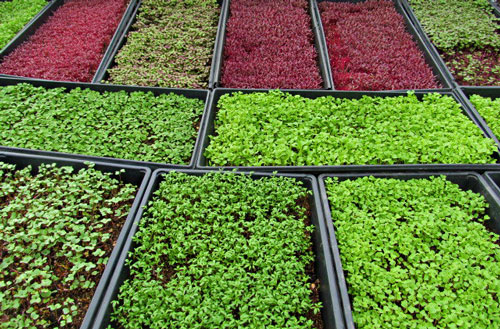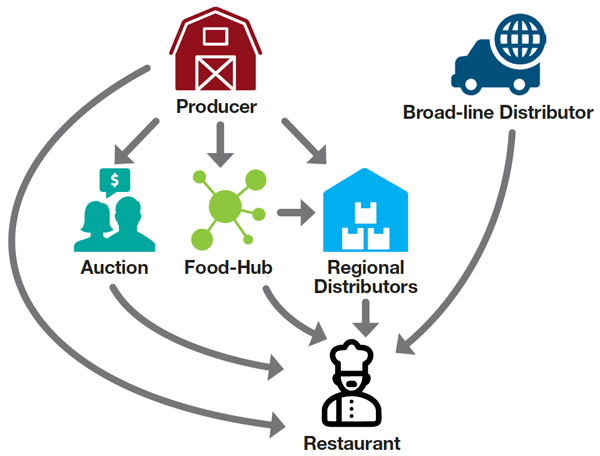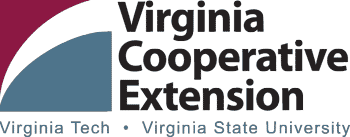Accessing Virginia’s Markets: Restaurants
- Introduction
- Survey Findings
- Purchasing Priorities & Barriers
- Recommendations
- Producer Checklist
- Helpful Resources
Introduction
 The restaurant market sector is one of the most diverse sectors when it comes to food procurement practices. As you’ve noticed, each restaurant has its own style, theme, cuisine, targeted palette, atmosphere, and so on. There are many competitors in this market sector and a broad variety of options. For example, when you dine-in at a [sit-down] restaurant, you are essentially paying for both a good and a service, whereas fast-food restaurants eliminate the extra costs of service by allowing food purchases to have near-instant delivery. There is also a heavy amount of direct and indirect competition, which is simply as follows: indirect competition is the conflict between vendors whose products or services are not the same but that could satisfy the same consumer need. Direct competition, however, is when businesses are selling products or services that are essentially the same. Using fast-food as an example, Wendy’s and McDonald’s would be considered direct competitors with one another, whereas Taco Bell and Wendy’s would be considered indirect competitors.
The restaurant market sector is one of the most diverse sectors when it comes to food procurement practices. As you’ve noticed, each restaurant has its own style, theme, cuisine, targeted palette, atmosphere, and so on. There are many competitors in this market sector and a broad variety of options. For example, when you dine-in at a [sit-down] restaurant, you are essentially paying for both a good and a service, whereas fast-food restaurants eliminate the extra costs of service by allowing food purchases to have near-instant delivery. There is also a heavy amount of direct and indirect competition, which is simply as follows: indirect competition is the conflict between vendors whose products or services are not the same but that could satisfy the same consumer need. Direct competition, however, is when businesses are selling products or services that are essentially the same. Using fast-food as an example, Wendy’s and McDonald’s would be considered direct competitors with one another, whereas Taco Bell and Wendy’s would be considered indirect competitors.
With the restaurant sector, you have food trucks, diners, fast-food restaurants, bars, and a plethora of other options all available to the consumer. The challenge for you as a producer comes in meeting both the demand and differentiating yourself and your products. The good news is that restaurants interested in purchasing your goods are [usually] high-end and are willing to pay a higher price for fresh, local, unique produce. Certain restaurant chains, however, have local produce featured in their menus, as well as the farms from which the produce came. An example would be the popular breakfast/brunch/lunch chain, First Watch. At First Watch they feature the farms and their growers that are a part of their menu, as well as which ingredients come from each farm. Featuring contributing growers adds a personal touch to the consumer’s dining experience, which is just as important as the food since the cost to the consumer reaches beyond the plate.
Survey Findings
In the survey we conducted to gain more insight into the involvement with local growers and restaurant markets, respondents indicated produce was purchased primarily from farmers markets, distributors, and direct from growers, and secondarily from food hubs and food service providers. All respondents were principal buyers for their organizations, with one respondent also being in charge of creating policies and procedures related to the procurement of fresh produce. All respondents reported purchasing produce daily during the peak season. Most reported also buying daily during the remainder of the year, whereas one reported buying bi-weekly. Overall, it is important to be aware of the type of restaurant (i.e. “mom and pop” vs. chain) and their readiness to source locally. This includes corporate policies as well as the volume needed. Just because some restaurants are chains, does not mean they will not source locally. Furthermore, chain restaurants are inherently more stringent on food safety regulation; therefore, it is important to consider these when a local producer is intending on approaching a restaurant for business purposes.
Purchasing Priorities & Barriers
Priorities
- Quality
- Availability
- Proximity of grower to buyer
- Product Variety/Diversity
- Delivery Capabilities
Barriers
- Insufficient Volume of Product
- Cost of Product
- Delivery Capabilities (Timing, Flexibility, etc.)
- Lack of Availability (Seasonality)
- Build relationships with purchaser and establish a regular communication schedule that takes into account the daily work-flow at the restaurant operation.
- It’s important to be aware of the type of restaurant (i.e. “mom and pop” vs. chain) and their readiness to source locally. This includes corporate policies as well as the volume needed. Just because some restaurants are chains, does not mean they will not source locally.
- Chain restaurants are inherently more stringent on food safety policies, so make sure to ask about vendor food safety requirements. This might include a 3rd party food safety audit and/or HACCP (Hazard Analysis and Critical Control Point) plan. Also keep in mind liability insurance requirements.
- Since restaurants can gain greater marketability by sourcing locally, this can work in your favor. Being able to tell your unique farm story and product characteristics is a great marketing technique! Personal farm tours highlighting your product with the chef can be particularly effective!
- Keep in mind that marketing yourself through a distributor may mitigate challenges presented by selling directly to the restaurant, such as storage, temperature control, and transportation.
- Be open to new product ideas in order to fill special unique niches that the restaurant marketplace is looking for.
- Remember product quality is important, so always sell the best product to your buyer—this is not the place to get rid of excess produce or seconds!
- Given VDACS statewide support for farming businesses, they might be able to serve as a middle point between producers and restaurants.
- It could be helpful to have a real-time statewide database of producers, which includes producer inventory and delivery capability. This would allow for more effective communication between both parties on the product being sold.
- Is the restaurant a “mom & pop” or chain restaurant?
- Is the restaurant interested in sourcing locally grown produce? If so, who is the point of contact for purchasing product?
- What food safety policies do they have? Do they require a 3rd party food safety audit, such as Good Agricultural Practices (GAP) certification? Are there other food safety considerations that your buyer requires, such as a HACCP (Hazard Analysis and Critical Control Point) plan implemented in your operation?
- What are their needs in terms of volume and product characteristics, handling such as pre-washing, storage, and transport, and delivery schedule? Are you able to meet all these needs?
- How will payment be handled—COD (cash on delivery) or invoicing—in order to allow greater cash flow?

Helpful Resources
Accessing Virginia’s Restaurant Market Sector: Fresh Produce Food Safety Considerations Factsheet
Enhancing the Safety of Locally Grown Produce
A series of fact sheets providing an introduction to best practices in the cultivation, harvest, transport, and marketing of fresh produce. Companion training is available through Cooperative Extension.
First Watch
First Watch has a seasonal menu that features local growers’ farms and produce. With locations across the United States, growers from all around have the chance to become a part of a popular, farm-friendly chain.
Grower’s Manual: A Template for Grower Cooperatives
Guidance on standards for pre-harvest and post-harvest practices and product specifications used with local foodservice establishments.
Market Ready™ Checklist for Direct Sales to Restaurants Business Practice Summary
A list of best practices outlining ideal starting points restaurant buyers would like to see regarding grower preparedness.
Market Ready™ for Restaurant Sales Full Report
A report by University of Kentucky detailing ‘best practices’ for producers to access the restaurants market.
Virginia Market Maker
The Market Maker portal is the largest and most in-depth national database for the agricultural industry. The portal provides a simple search tool to connect buyers, farmers/ranchers, fisheries, farmers markets, processors/packers, wineries, restaurants and more.
